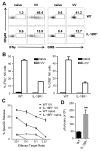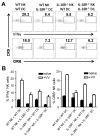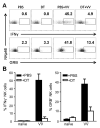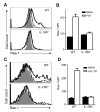NK cell-extrinsic IL-18 signaling is required for efficient NK-cell activation by vaccinia virus
- PMID: 24846540
- PMCID: PMC4165707
- DOI: 10.1002/eji.201344134
NK cell-extrinsic IL-18 signaling is required for efficient NK-cell activation by vaccinia virus
Abstract
NK cells are important for the control of vaccinia virus (VV) in vivo. Recent studies have shown that multiple pathways are required for effective activation of NK cells. These include both TLR-dependent and -independent pathways, as well as the NKG2D activating receptor that recognizes host stress-induced NKG2D ligands. However, it remains largely unknown what controls the upregulation of NKG2D ligands in response to VV infection. In this study using C57BL/6 mice, we first showed that IL-18 is critical for NK-cell activation and viral clearance. We then demonstrated that IL-18 signaling on both NK cells and DCs is required for efficient NK-cell activation upon VV infection in vitro. We further showed in vivo that efficient NK-cell activation in response to VV is dependent on DCs and IL-18 signaling in non-NK cells, suggesting an essential role for NK cell-extrinsic IL-18 signaling in NK-cell activation. Mechanistically, IL-18 signaling in DCs promotes expression of Rae-1, an NKG2D ligand. Collectively, our data reveal a previously unrecognized role for NK cell-extrinsic IL-18 signaling in NK-cell activation through upregulation of NKG2D ligands. These observations may provide insights into the design of effective NK-cell-based therapies for viral infections and cancer.
Keywords: IL-18; NK cells; NKG2D; Rae-1; Vaccinia virus.
© 2014 WILEY-VCH Verlag GmbH & Co. KGaA, Weinheim.
Figures





Similar articles
-
IL-18-dependent NKG2D ligand upregulation on accessory cells is mediated by the PI3K/GSK-3 pathway.J Leukoc Biol. 2017 Jun;101(6):1317-1323. doi: 10.1189/jlb.2A0816-342R. Epub 2017 Mar 10. J Leukoc Biol. 2017. PMID: 28283665 Free PMC article.
-
Direct TLR2 signaling is critical for NK cell activation and function in response to vaccinia viral infection.PLoS Pathog. 2010 Mar 12;6(3):e1000811. doi: 10.1371/journal.ppat.1000811. PLoS Pathog. 2010. PMID: 20300608 Free PMC article.
-
Both NK cell-intrinsic and -extrinsic STAT1 signaling are required for NK cell response against vaccinia virus.J Immunol. 2013 Jul 1;191(1):363-8. doi: 10.4049/jimmunol.1202714. Epub 2013 Jun 3. J Immunol. 2013. PMID: 23733873 Free PMC article.
-
Murine NKG2D ligands: "double, double toil and trouble".Mol Immunol. 2009 Mar;46(6):1011-9. doi: 10.1016/j.molimm.2008.09.035. Epub 2008 Dec 10. Mol Immunol. 2009. PMID: 19081632 Free PMC article. Review.
-
Regulation of NKG2D-Dependent NK Cell Functions: The Yin and the Yang of Receptor Endocytosis.Int J Mol Sci. 2017 Aug 2;18(8):1677. doi: 10.3390/ijms18081677. Int J Mol Sci. 2017. PMID: 28767057 Free PMC article. Review.
Cited by
-
The NKG2D/NKG2DL Axis in the Crosstalk Between Lymphoid and Myeloid Cells in Health and Disease.Front Immunol. 2018 Apr 23;9:827. doi: 10.3389/fimmu.2018.00827. eCollection 2018. Front Immunol. 2018. PMID: 29740438 Free PMC article. Review.
-
Selective reconstitution of IFN‑γ gene function in Ncr1+ NK cells is sufficient to control systemic vaccinia virus infection.PLoS Pathog. 2020 Feb 5;16(2):e1008279. doi: 10.1371/journal.ppat.1008279. eCollection 2020 Feb. PLoS Pathog. 2020. PMID: 32023327 Free PMC article.
-
NLRP3 Inflammasome Participates in Host Response to Neospora caninum Infection.Front Immunol. 2018 Jul 30;9:1791. doi: 10.3389/fimmu.2018.01791. eCollection 2018. Front Immunol. 2018. PMID: 30105037 Free PMC article.
-
IL-18-dependent NKG2D ligand upregulation on accessory cells is mediated by the PI3K/GSK-3 pathway.J Leukoc Biol. 2017 Jun;101(6):1317-1323. doi: 10.1189/jlb.2A0816-342R. Epub 2017 Mar 10. J Leukoc Biol. 2017. PMID: 28283665 Free PMC article.
-
IL-18 production is required for the generation of a Th1 response during experimental chromoblastomycosis.PLoS One. 2025 May 2;20(5):e0322127. doi: 10.1371/journal.pone.0322127. eCollection 2025. PLoS One. 2025. PMID: 40315193 Free PMC article.
References
-
- Lee SH, Miyagi T, Biron CA. Keeping NK cells in highly regulated antiviral warfare. Trends Immunol. 2007;28:252–259. - PubMed
-
- Bukowski JF, Woda BA, Habu S, Okumura K, Welsh RM. Natural killer cell depletion enhances virus synthesis and virus-induced hepatitis in vivo. J Immunol. 1983;131:1531–1538. - PubMed
-
- Natuk RJ, Welsh RM. Accumulation and chemotaxis of natural killer/large granular lymphocytes at sites of virus replication. J Immunol. 1987;138:877–883. - PubMed
-
- Martinez J, Huang X, Yang Y. Direct action of type I IFN on NK cells is required for their activation in response to vaccinia viral infection in vivo. J Immunol. 2008;180:1592–1597. - PubMed
Publication types
MeSH terms
Substances
Grants and funding
LinkOut - more resources
Full Text Sources
Other Literature Sources
Miscellaneous

